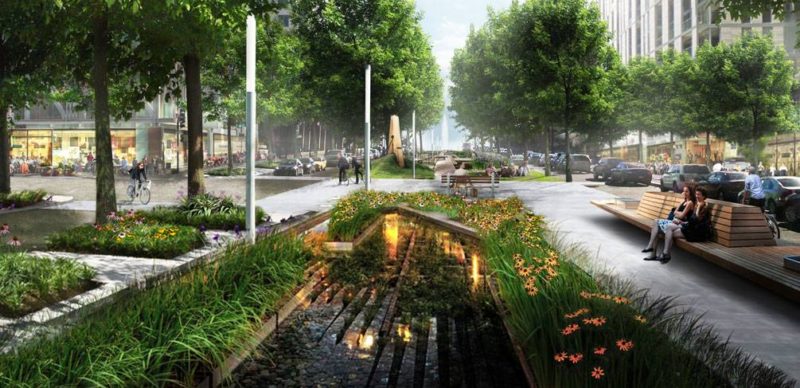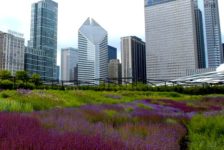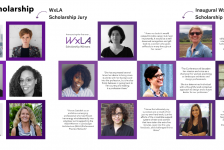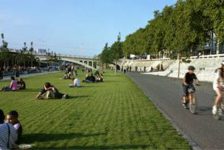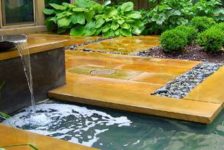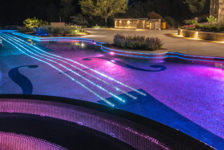Article by Erin Tharp. Ecodistricts by ZGF ARCHITECTS LLP, in Southwest Washington, DC, United States of America. It could easily be argued that the word “sustainability” was the most talked about buzzword in the design world in 2015, and with good reason. Across the world there is an ongoing movement to create communities that are more eco-friendly, pedestrian friendly, and less reliant on non-renewable resources; or sustainable. But there may be a new buzzword on the horizon for 2016 and ZGF Architects can take credit for creating it. That word would be Ecodistrict.
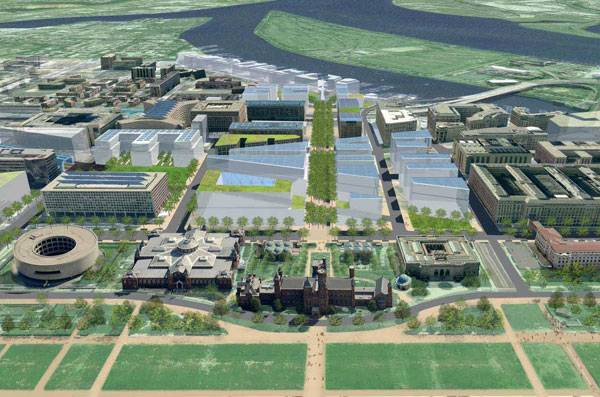
An Ecodistrict. Image credit: Courtesy of NCPC, Image by ZGF Architects
Ecodistricts
According to ZGF, an Ecodistrict “is a place that relies on a strong design idea supported with enduring community stewardship at multiple scales. It requires the concerted action of government and grassroots efforts to encompass the full potential of community shared interests, resources, and resolve. Opportunities are found where action can be taken and supported across the community through collective pursuit of individual self-interest.” But what does that mean? Basically, at the heart of an Ecodistrict is the idea that a community can make improvements that save resources and by working together, the cost is far less. Also, by planning for the system as a whole instead of just a small piece of it, placemaking is much improved.
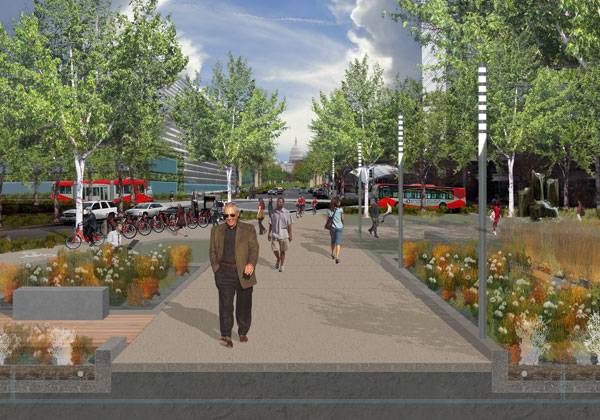
An Ecodistrict. Image credit: Courtesy of NCPC, Image by ZGF Architects
This improvement stems from the idea that every design decision, no matter how small, can have a significant impact on the district as a whole. With this in mind, designers are able to combine all the elements of public infrastructure together at the district level to achieve improvements in energy and water efficiency, as well as in waste reduction and mobility.

An Ecodistrict. Image credit: Courtesy of NCPC, Image by ZGF Architects
This is not a new idea; for years cities have been looking at mobility options at the district or city level to create systems that are both functional and efficient. ZGF Architects knew this, and saw that it worked, and decided to apply these same principles to develop systems for water and energy that will help to facilitate resource sharing and, according to designers. ZGF relied on their past experience of working closely with communities to develop the ideas that form the Ecodistrict. They also strived to focus their attention on the larger context of a place, and not just property lines, while also considering all of the details at the smallest of scales.
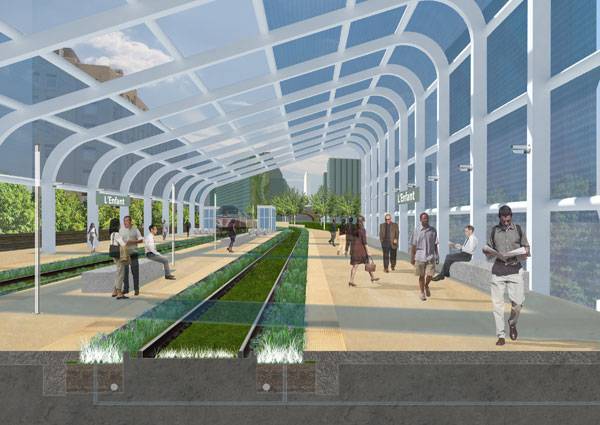
An Ecodistrict. Image credit: Courtesy of NCPC, Image by ZGF Architects
They applied the systems of energy, water, mobility, materials management, air, natural and urban ecosystems, and community to five district projects, which could potentially be used as protocol in other cities. The following two are examples:
1. National Capital Planning Commission / U.S. General services Administration – SW Ecodistrict Plan – Washington DC Working with the DC Office of Planning and 17 other local and federal agencies, ZGF’s plan calls for a reduction in greenhouse gas emissions from the federal employment center. Their plan accomplishes this through a mixed-use neighborhood that will be home to cultural attractions, public spaces, offices, residences and amenities. Through this mix, the district will be able to share resources, and will allow the waste from one building to supply resources for another building. Buildings will share water, gas, electricity, and heating and cooling to create a 24-hour synergy.

An Ecodistrict. Image credit: Courtesy of NCPC, Image by ZGF Architects
This Ecodistrict is designed to combine residential, commercial, recreational, and educational uses to support a community lifestyle for a new high-tech and creative community. The framework for the community is “net-zero” ready for water, waste, and energy. Rain, wind, sunlight, and ground source energy are harnessed to offset energy and resource needs and wastes of a typical urban area. A central utility plant is also used to minimize waste and pollution.
Living City Competition – People’s Choice Award In 2011 ZGF combined elements from their previous projects together in a new project centered on their Ecodistrict theory in the Living City Competition sponsored by the
International Future Institute and the
National Trust for Historic Preservation. The competition called for teams to show how existing cities could be transformed to achieve and surpass the Living Building Challenge 2.0, which is the built environment’s most rigorous performance standard. More than 80 teams submitted entries focusing on 69 different cities in 21 countries.
ZGF won the People’s Choice Award for their collaboration with
Portland Sustainability Institute,
CH2M Hill,
David Evans and Associates,
Greenworks PC,
Newlands and Company Inc.,
Portland State University, and the
Institute for Sustainable Solutions and Sparling. Their entry focused on an exploration of the symbiosis between five Ecodistricts in Portland, Oregon, as well as regional systems. It also examined how certain strategies in a single district, Gateway, could contribute to the city’s overall performance.
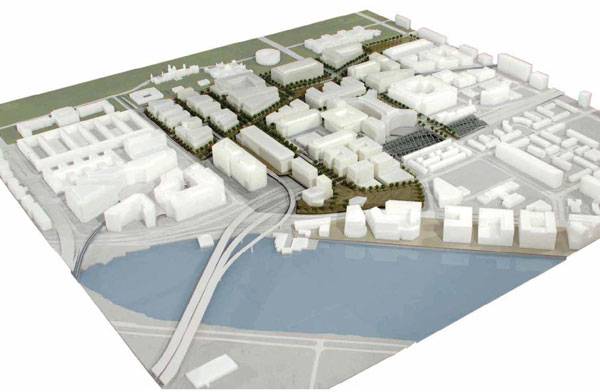
An Ecodistrict. Image credit: Courtesy of NCPC, Image by ZGF Architects
These strategies focused on a rich street life, net-zero energy and water, green infrastructure and urban agriculture. First by shifting focus on streets from automobiles to pedestrians and bikes, residents are able to move between homes, services and the regional transit center with more ease. This new focus creates a richer street life for all involved and helps create spaces for communication and connection.
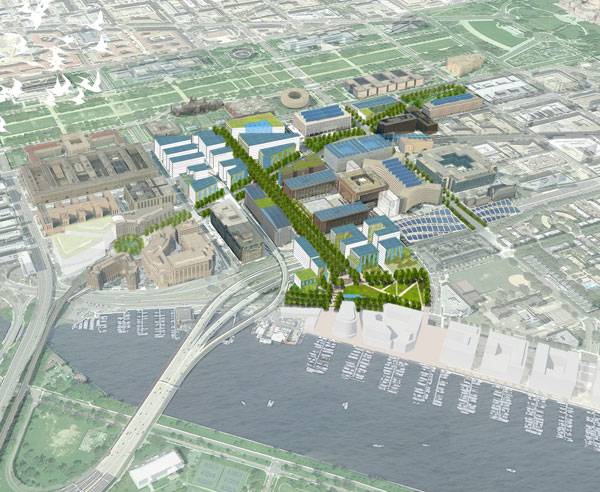
An Ecodistrict. Image credit: Courtesy of NCPC, Image by ZGF Architects
Second, by scaling infrastructure to the neighborhood level, residents are able to achieve net-zero energy and water. To do this, thermal pipes are used to bring geothermal heat to buildings, sewer mining and organic waste provide additional firepower, and living machines throughout the district are used to clean water, which is then distributed to each building through an underground network laid under the streets. Third, green streets and a new greenway allow the growing of native habitat and food while treating and conveying water. Transforming a six-lane asphalt highway into a greenway for biking, walking and urban agriculture does this. Here, organic wastes from stormwater and other sources are captured in tunnels next to the remaining two lanes where it is then collected, treated and reused as freshwater for the neighborhood.
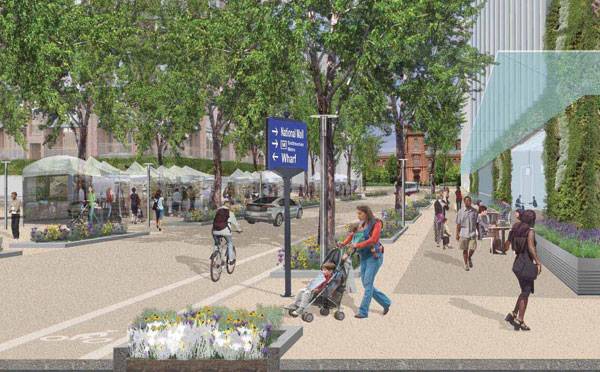
An Ecodistrict. Image credit: Courtesy of NCPC, Image by ZGF Architects
Finally, in this mock-up, residents grow food on every available surface, including abandoned big box stores, greenways, rooftops, and green walls. Small livestock are also allowed within the district, which helps to generate one of Gateway’s most valuable fuels – food. People would be able to sample food on the greenway that was sourced 100 feet away. In their example they found that the rooftops of the former big box store alone would produce up to 4,400,000 kWh per year with solar power that would provide electricity for 790 households, while the inside of the building could be used as a school or community center. In closing, ZGF wants the takeaway from this project to be guiding principles for future projects.
The principles are: build projects where they will be wanted; build projects that will pay for themselves and enrich the lives of others; build projects that will attract partners and encourage other like projects; build projects in places that encourage community stewardship; and finally, build projects that will capture good ideas. They also reiterate that improvements at the streetscape are imperative to transforming a district and that leads to regional change. These changes could be as small as a new utility, a new open space, or a new building. These are all things ZGF has been doing for the past 50 years and things they will continue to do and advocate for.
Can you think of any communities that would benefit from this Ecodistrict approach? Let us know in the comments section below! Click here to comment 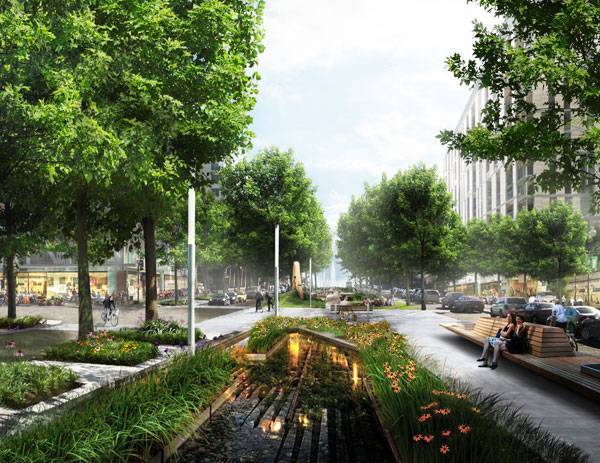
An Ecodistrict. Image credit: Courtesy of NCPC, Image by ZGF Architects
Learn more about ZGF ARCHITECTS LLP and Ecodistricts:
Website: www.zgf.com Facebook: www.facebook.com/ZGFarchitects Recommended Reading:
Article by Erin Tharp. Return to Homepage
Published in Blog










